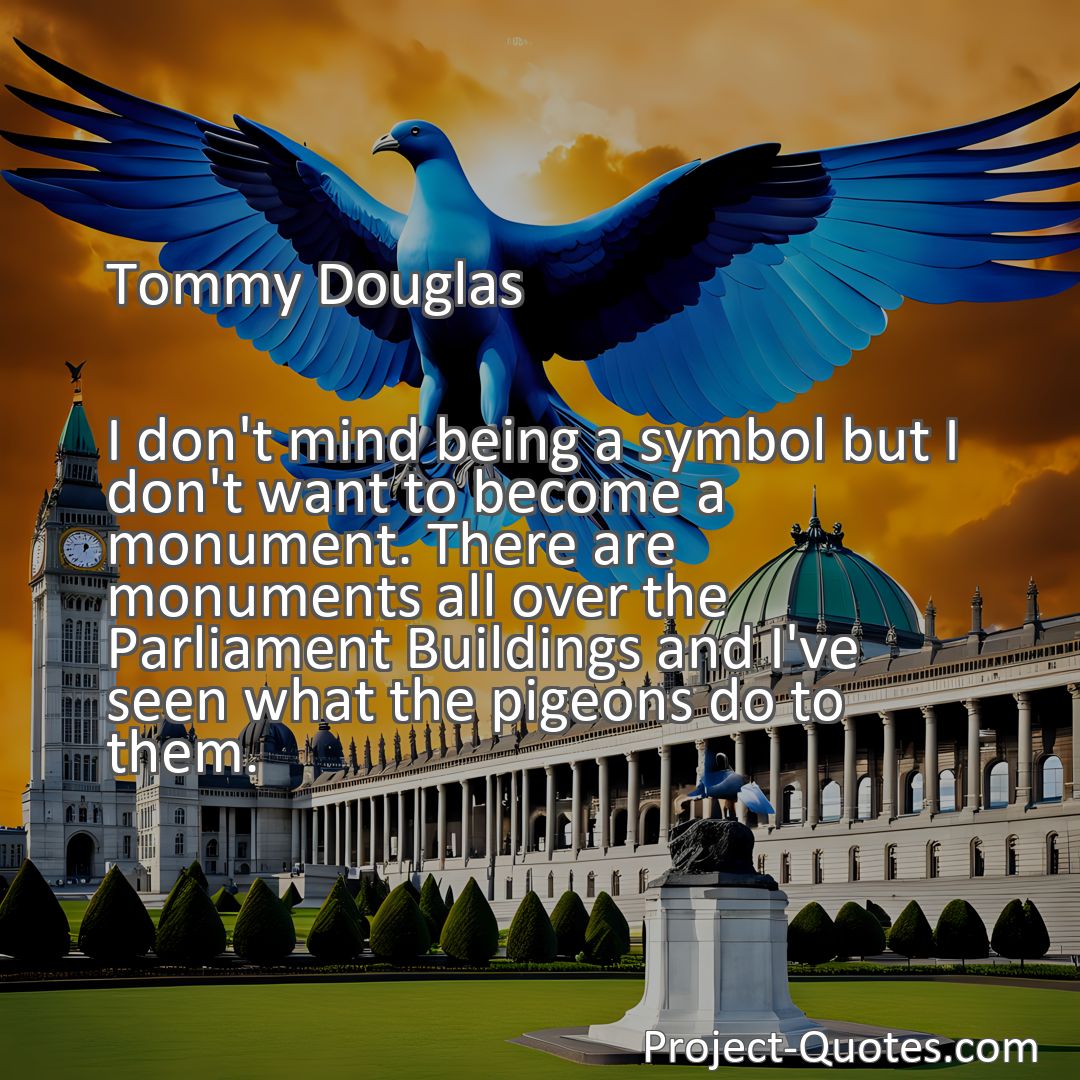I don’t mind being a symbol but I don’t want to become a monument. There are monuments all over the Parliament Buildings and I’ve seen what the pigeons do to them.
Tommy Douglas
Change Must Remain Active Participants: The Impact of Tommy Douglas Tommy Douglas, a Canadian politician and social activist, understood the importance of remaining an active force of change rather than becoming a stagnant monument. His quote reflects his desire to leave a lasting impact by constantly adapting and evolving with the needs of the people. Douglas’ legacy serves as a call to action for all of us to embrace our roles as symbols of change and to resist the temptation to become static and irrelevant.
Table of Contents
- 1 I don’t mind being a symbol but I don’t want to become a monument. There are monuments all over the Parliament Buildings and I’ve seen what the pigeons do to them.
- 2 Tommy Douglas
- 3 Meaning of Quote – I don’t mind being a symbol but I don’t want to become a monument. There are monuments all over the Parliament Buildings and I’ve seen what the pigeons do to them.
- 4 Freely Shareable Quote Image
- 5 Related
Meaning of Quote – I don’t mind being a symbol but I don’t want to become a monument. There are monuments all over the Parliament Buildings and I’ve seen what the pigeons do to them.
“I don’t mind being a symbol, but I don’t want to become a monument,” once said Tommy Douglas. In these few words, the Canadian politician and social activist perfectly captures the essence of his mindset. The quote reflects his desire to have a lasting impact on society, not as an immovable figure, but as a dynamic force of change. Douglas understood that while monuments may be revered and respected, they are often forgotten, untouched by progress. Instead, he aimed to be a symbol, a living embodiment of his ideals, constantly adapting and evolving with the needs of the people.
To fully comprehend the significance of this quote, we must first understand the remarkable individual behind it. Tommy Douglas was a prominent figure in Canadian history, most notably as the “Father of Medicare.” Born in Scotland in 1904, Douglas immigrated to Canada with his family when he was just six years old. Growing up in Winnipeg’s North End, he experienced firsthand the hardships and inequalities that plagued many working-class families during the early 20th century.
Throughout his life, Douglas fought tirelessly for social justice, advocating for workers’ rights, racial equality, and accessible healthcare. His dedication to the welfare of others led him to become the leader of the Cooperative Commonwealth Federation (CCF), a left-wing political party that later transformed into the New Democratic Party (NDP). As the premier of Saskatchewan from 1944 to 1961, Douglas implemented groundbreaking policies that laid the foundation for the universal healthcare system that Canada takes pride in today.
When Douglas declares, “I don’t mind being a symbol,” he acknowledges the significance of his role in shaping Canadian society. Symbolism holds great power, as it represents ideas and values that transcend an individual’s existence. Douglas recognized that his actions, beliefs, and achievements had the ability to inspire generations to come. By striving to be a symbol, he aimed to leave a lasting impact on people’s hearts and minds.
However, Douglas also emphasizes that he does not wish to become a monument. In doing so, he draws attention to the limitations and dangers of becoming static and unchanging. Monuments can often fall victim to stagnation, no longer reflecting the evolving needs and values of society. Like the statues that adorn Parliament Buildings, they become immune to progress, preserved in time, but gradually losing relevance.
Douglas, on the other hand, was a dynamic force, always seeking avenues for improvement and growth. He brought about significant change through his relentless campaigning and the implementation of policies that addressed the pressing issues of his time. Douglas understood that to truly impact society, one must be open to adaptation and willing to challenge the status quo.
In Douglas’ eyes, becoming a monument also carries the risk of becoming a target for criticism and disregard. Monuments are not exempt from the weathering effects of time, nor are they immune to the occasional pigeon. It is the pigeons, in this metaphor, that represent the forces of apathy, complacency, and the desire to tear down those who dare to challenge the norms. By avoiding the fate of a monument, Douglas aimed to remain relevant, continuing to fight for the causes close to his heart.
The eloquence of this quote lies not only in its simplicity but also in its relatability. It is a sentiment that resonates with those who strive for progress and change within their own spheres of influence. It serves as a reminder that true impact comes from constantly adapting and challenging oneself and the systems in which we operate.
In today’s world, where movements for social justice and equality continue to gain momentum, Douglas’ words hold particular relevance. They remind us that symbols of change must remain active participants in the struggles they represent. Whether fighting for racial justice, gender equality, or climate action, we must remember that our impact is not limited to our actions alone. It is the ability to inspire and mobilize others that truly defines our success.
Douglas’ quote has stood the test of time as a testament to his visionary leadership and unwavering commitment to progress. It serves as a call to action for us all, urging us to embrace our roles as symbols of change and to resist the temptation to become stagnant monuments. By embodying the spirit of constant growth and adaptation, we can ensure that the causes we champion remain alive and vibrant for generations to come.
So, let us remember Tommy Douglas not as a motionless figure etched in stone but as a symbol of compassion, justice, and progress. May his legacy continue to inspire us to challenge the status quo, fight for what is right, and create a better future for all.
I hope this quote inspired image brings you hope and peace. Share it with someone who needs it today!


